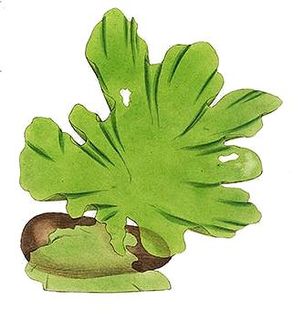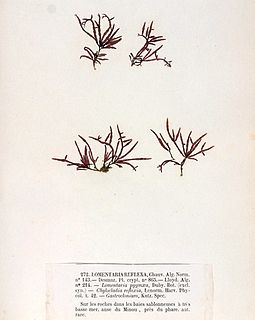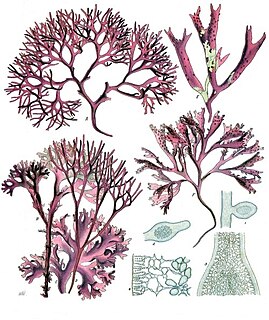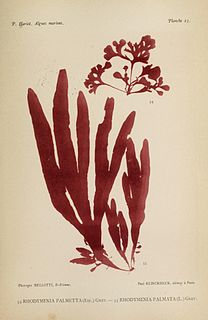
Algae is an informal term for a large and diverse group of photosynthetic eukaryotic organisms. It is a polyphyletic grouping that includes species from multiple distinct clades. Included organisms range from unicellular microalgae, such as Chlorella, Prototheca and the diatoms, to multicellular forms, such as the giant kelp, a large brown alga which may grow up to 50 metres (160 ft) in length. Most are aquatic and autotrophic and lack many of the distinct cell and tissue types, such as stomata, xylem and phloem, which are found in land plants. The largest and most complex marine algae are called seaweeds, while the most complex freshwater forms are the Charophyta, a division of green algae which includes, for example, Spirogyra and stoneworts.

Phycology is the scientific study of algae. Also known as algology, phycology is a branch of life science.

Chlamydomonas is a genus of green algae consisting of about 325 species all unicellular flagellates, found in stagnant water and on damp soil, in freshwater, seawater, and even in snow as "snow algae". Chlamydomonas is used as a model organism for molecular biology, especially studies of flagellar motility and chloroplast dynamics, biogenesis, and genetics. One of the many striking features of Chlamydomonas is that it contains ion channels (channelrhodopsins) that are directly activated by light. Some regulatory systems of Chlamydomonas are more complex than their homologs in Gymnosperms, with evolutionarily related regulatory proteins being larger and containing additional domains.

The sea lettuces comprise the genus Ulva, a group of edible green algae that is widely distributed along the coasts of the world's oceans. The type species within the genus Ulva is Ulva lactuca, lactuca being Latin for "lettuce". The genus also includes the species previously classified under the genus Enteromorpha, the former members of which are known under the common name green nori.

The Charophyta or charophytes is a group of freshwater green algae, sometimes treated as a division, but also as a superdivision, or an unranked clade. The terrestrial plants, the Embryophyta most likely emerged within Charophyta, possibly from terrestrial unicellular charophytes, with the class Zygnematophyceae as a sister group.

Porphyra is a coldwater seaweed that grows in cold, shallow seawater. More specifically, it belongs to red algae phylum of laver species, comprising approximately 70 species. It grows in the intertidal zone, typically between the upper intertidal zone and the splash zone in cold waters of temperate oceans. In East Asia, it is used to produce the sea vegetable products nori and gim. There are considered to be 60 to 70 species of Porphyra worldwide and seven around Britain and Ireland where it has been traditionally used to produce edible sea vegetables on the Irish Sea coast. Porphyra is a chief source of plant-based vitamin B12.

The Archaeplastida are a major group of eukaryotes, comprising the red algae (Rhodophyta), the green algae, and the land plants, and some smaller groups such as the glaucophytes. All of the lineages of Archaeplastida have become photoautotrophic, except for the lineage Rhodelphidia, sister to the Rhodophyta, which is still a non-photosynthetic predatorial (eukaryotrophic) flagellate. The Archaeplastida have chloroplasts that are surrounded by two membranes, suggesting that they were acquired directly through a single endosymbiosis event by feeding on a cyanobacterium. All other groups which have chloroplasts, besides the amoeboid Paulinella chromatophora, have chloroplasts surrounded by three or four membranes, suggesting they were acquired secondarily from red or green algae. Unlike red and green algae, glaucophytes have never been involved in secondary endosymbiosis events.
The history of phycology is the history of the scientific study of algae. Human interest in plants as food goes back into the origins of the species and knowledge of algae can be traced back more than two thousand years. However, only in the last three hundred years has that knowledge evolved into a rapidly developing science.

Gastroclonium is a genus of red algae (Rhodophyta) in the family Champiaceae. As of November 2018, according to AlgaeBase, it comprises the following species:

Rhodochorton is a genus of filamentous red alga adapted to low light levels. It may form tufts or a thin purple "turf" up to 5 millimetres high. The filaments branch infrequently, usually at the tips.

Red algae, or Rhodophyta, are one of the oldest groups of eukaryotic algae. The Rhodophyta also comprises one of the largest phyla of algae, containing over 7,000 currently recognized species with taxonomic revisions ongoing. The majority of species (6,793) are found in the Florideophyceae (class), and mostly consist of multicellular, marine algae, including many notable seaweeds. Red algae are abundant in marine habitats but are relatively rare in freshwaters. Approximately 5% of the red algae occur in freshwater environments with greater concentrations found in warmer areas. Except for two coastal cave dwelling species in the asexual class Cyanidiophyceae, there are no terrestrial species, which may be due to an evolutionary bottleneck where the last common ancestor lost about 25% of its core genes and much of its evolutionary plasticity.

Rhodomelaceae is estimated to be the largest red algae family, with about 125 genera and over 700 species.

Rhodymenia is a genus of red algae, containing the following species:

Acrochaetiales is an order of red algae.

Laurencia is a genus of red algae that grow in temperate and tropical shore areas, in littoral to sublittoral habitats, at depths up to 65 m (213 ft).
Galdieria sulphuraria is an extremophilic unicellular species of red algae. It is the type species of the genus Galdieria. It is known for its broad metabolic capacities, including photosynthesis and heterotrophic growth on over 50 different extracellular carbon sources. The members of the class Cyanidiophyceae are among the most acidophilic known photosynthetic organisms, and the growth conditions of G. sulphuraria – pH between 0 and 4, and temperatures up to 56 °C – are among the most extreme known for eukaryotes. Analysis of its genome suggests that its thermoacidophilic adaptations derive from horizontal gene transfer from archaea and bacteria, another rarity among eukaryotes.

Bangiaceae is a family of red algae in the order Bangiales. It contains laver, used to make laverbread, and the species used to make nori as well as other edible seaweeds.

Marine primary production is the chemical synthesis in the ocean of organic compounds from atmospheric or dissolved carbon dioxide. It principally occurs through the process of photosynthesis, which uses light as its source of energy, but it also occurs through chemosynthesis, which uses the oxidation or reduction of inorganic chemical compounds as its source of energy. Almost all life on Earth relies directly or indirectly on primary production. The organisms responsible for primary production are called primary producers or autotrophs.















